duxgregis
I hope no one ever sees this again.
74 posts
Latest Posts by duxgregis
Happy 4th of July… From Space!
In Hollywood blockbusters, explosions and eruptions are often among the stars of the show. In space, explosions, eruptions and twinkling of actual stars are a focus for scientists who hope to better understand their births, lives, deaths and how they interact with their surroundings. Spend some of your Fourth of July taking a look at these celestial phenomenon:

Credit: NASA/Chandra X-ray Observatory
An Astral Exhibition
This object became a sensation in the astronomical community when a team of researchers pointed at it with our Chandra X-ray Observatory telescope in 1901, noting that it suddenly appeared as one of the brightest stars in the sky for a few days, before gradually fading away in brightness. Today, astronomers cite it as an example of a “classical nova,” an outburst produced by a thermonuclear explosion on the surface of a white dwarf star, the dense remnant of a Sun-like star.

Credit: NASA/Hubble Space Telescope
A Twinkling Tapestry
The brilliant tapestry of young stars flaring to life resemble a glittering fireworks display. The sparkling centerpiece is a giant cluster of about 3,000 stars called Westerlund 2, named for Swedish astronomer Bengt Westerlund who discovered the grouping in the 1960s. The cluster resides in a raucous stellar breeding ground located 20,000 light-years away from Earth in the constellation Carina.
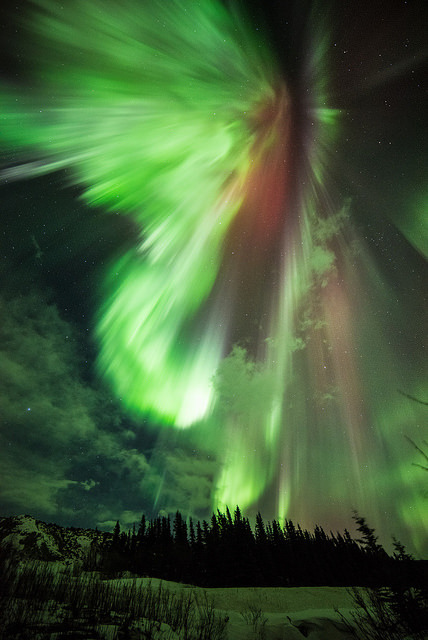
Credit: NASA/THEMIS/Sebastian Saarloos
An Illuminating Aurora
Sometimes during solar magnetic events, solar explosions hurl clouds of magnetized particles into space. Traveling more than a million miles per hour, these coronal mass ejections, or CMEs, made up of hot material called plasma take up to three days to reach Earth. Spacecraft and satellites in the path of CMEs can experience glitches as these plasma clouds pass by. In near-Earth space, magnetic reconnection incites explosions of energy driving charged solar particles to collide with atoms in Earth’s upper atmosphere. We see these collisions near Earth’s polar regions as the aurora. Three spacecraft from our Time History of Events and Macroscale Interactions during Substorms (THEMIS) mission, observed these outbursts known as substorms.

Credit: NASA/Hubble Space Telescope//ESA/STScI
A Shining Supermassive Merger
Every galaxy has a black hole at its center. Usually they are quiet, without gas accretions, like the one in our Milky Way. But if a star creeps too close to the black hole, the gravitational tides can rip away the star’s gaseous matter. Like water spinning around a drain, the gas swirls into a disk around the black hole at such speeds that it heats to millions of degrees. As an inner ring of gas spins into the black hole, gas particles shoot outward from the black hole’s polar regions. Like bullets shot from a rifle, they zoom through the jets at velocities close to the speed of light. Astronomers using our Hubble Space Telescope observed correlations between supermassive black holes and an event similar to tidal disruption, pictured above in the Centaurus A galaxy.

Credit: NASA/Hubble Space Telescope/ESA
A Stellar Explosion
Supernovae can occur one of two ways. The first occurs when a white dwarf—the remains of a dead star—passes so close to a living star that its matter leaks into the white dwarf. This causes a catastrophic explosion. However most people understand supernovae as the death of a massive star. When the star runs out of fuel toward the end of its life, the gravity at its heart sucks the surrounding mass into its center. At the turn of the 19th century, the binary star system Eta Carinae was faint and undistinguished. Our Hubble Telescope captured this image of Eta Carinae, binary star system. The larger of the two stars in the Eta Carinae system is a huge and unstable star that is nearing the end of its life, and the event that the 19th century astronomers observed was a stellar near-death experience. Scientists call these outbursts supernova impostor events, because they appear similar to supernovae but stop just short of destroying their star.

Credit: NASA/GSFC/SDO
An Eye-Catching Eruption
Extremely energetic objects permeate the universe. But close to home, the Sun produces its own dazzling lightshow, producing the largest explosions in our solar system and driving powerful solar storms.. When solar activity contorts and realigns the Sun’s magnetic fields, vast amounts of energy can be driven into space. This phenomenon can create a sudden flash of light—a solar flare.The above picture features a filament eruption on the Sun, accompanied by solar flares captured by our Solar Dynamics Observatory.
Make sure to follow us on Tumblr for your regular dose of space: http://nasa.tumblr.com
Navigating Space by the Stars





A sextant is a tool for measuring the angular altitude of a star above the horizon and has helped guide sailors across oceans for centuries. It is now being tested aboard the International Space Station as a potential emergency navigation tool for guiding future spacecraft across the cosmos. The Sextant Navigation investigation will test the use of a hand-held sextant that utilizes star sighting in microgravity.
Read more about how we’re testing this tool in space!
Make sure to follow us on Tumblr for your regular dose of space: http://nasa.tumblr.com
This is the NASA I love to see
May the 4th Be With You
Happy May the 4th!
How many connections does America’s space program have with the fictional world of Star Wars? More than you might think…
Join us as we highlight a few of the real-world TIE-ins between us and Star Wars:
Space Laser


Lasers in space sounds like something straight out of Star Wars, but it’s also a reality for us. Our own GEDI (yes, like Jedi) instrument will launch later this year to the International Space Station.


GEDI stands for the Global Ecosystem Dynamics Investigation lidar. It will study the height of trees and forests, using three lasers split into eight tracks, and create a 3D map of forests around the planet.

With GEDI’s new tree maps, we’ll get a better understanding of how much carbon is stored in forests all over Earth, and how forests will be able to absorb increasing carbon dioxide in the atmosphere.
The Jedi knights may help protect a galaxy far, far away, but our GEDI will help us study and understand forest changes right here on Earth.

Another JEDI

There’s another Jedi in town and it happens to be orbiting the planet Jupiter. Our Juno spacecraft, which arrived at the gas giant in July 2016, has an instrument on board that goes by the name of JEDI - the Jupiter Energetic Particle Detector Instrument.
While it doesn’t use a light saber or channel “the force”, it does measure high-energy particles near Jupiter. Data collected with the JEDI instrument will help us understand how the energy of Jupiter’s rotation is being funneled into its atmosphere and magnetosphere.
Death Star Moon

We know what you’re thinking…”That’s no moon.” But actually, it is! This is a real picture taken by our Cassini spacecraft of Saturn’s moon Mimas. In this view taken on Cassini’s closest-ever flyby of Mimas, the large Herschel Crater dominates, making the moon look like the Death Star. Herschel Crater is 130 kilometers, or 80 miles, wide and covers most of the right of this image.
We Actually Do Have the Droids You’re Looking For

We have robots roving and exploring all over the solar system, but it’s our own “R2” that’s most likely to resonate with Star Wars fans. Robonaut 2, launched in 2011, is working along side humans on board the International Space Station, and may eventually help with spacewalks too dangerous for humans. Incidentally, an earlier version of Robonaut bore a strong “facial” resemblance to enigmatic bounty hunter Boba Fett.

Another “droid” seen on the space station was directly inspired by the saga. In 1999, then Massachusetts Institute of Technology (MIT) professor David Miller, showed the original 1977 Star Wars to his students on their first day of class. After the scene where hero Luke Skywalker learns lightsaber skills by sparring with a floating droid “remotes” on the Millennium Falcon, Miller stood up and pointed: “I want you to build me some of those.”
The result was “SPHERES,” or Synchronized Position Hold, Engage, Reorient, Experimental Satellites. Originally designed to test spacecraft rendezvous and docking maneuvers, the bowling-ball size mini-satellites can now be powered by smart phones.
A few more TIE ins…

When space shuttle Atlantis left the International Space Station after 2007’s STS-117 mission, it caught a view of the station that looked to some like a TIE fighter.

The “TIE-ins” go beyond casual resemblance to real engineering. We already use actual ion engines (“TIE” stands for “Twin Ion Engines”) on spacecraft like Dawn, currently orbiting the dwarf planet Ceres. In fact, Dawn goes one better with three ion engines.
Want more Star Wars connections? Check out THIS Tumblr to learn about the REAL planets we’ve found outside our solar system that resemble planets from the movie.
Take THIS quiz to see if you know more about the Milky Way galaxy or a galaxy far, far away.
Make sure to follow us on Tumblr for your regular dose of space: http://nasa.tumblr.com.
"I just want someone to love me like gaius baltar loves living"
Best tag ever.
How accurate
i just did a tarot reading
it said ur a bitch
Mars is the third solar body inhabited by humans. (cir. 2029)
Ten interesting facts about Mars
The ancient Sumerians believed that Mars was Nergal, the god of war and plague. During Sumerian times, Nergal was a minor deity of little significance, but, during later times, his main cult center was the city of Nineveh. In Mesopotamian texts, Mars is referred to as the “star of judgement of the fate of the dead”. The existence of Mars as a wandering object in the night sky was recorded by the ancient Egyptian astronomers and, by 1534 BCE, they were familiar with the retrograde motion of the planet. By the period of the Neo-Babylonian Empire, the Babylonian astronomers were making regular records of the positions of the planets and systematic observations of their behavior. For Mars, they knew that the planet made 37 synodic periods, or 42 circuits of the zodiac, every 79 years. They invented arithmetic methods for making minor corrections to the predicted positions of the planets.

Mars is the fourth planet from the Sun and the second-smallest planet in the Solar System after Mercury.

The bright rust color Mars is known for is due to iron-rich minerals in its regolith — the loose dust and rock covering its surface. The soil of Earth is a kind of regolith, albeit one loaded with organic content. According to NASA, the iron minerals oxidize, or rust, causing the soil to look red.

The rotational period and seasonal cycles of Mars are likewise similar to those of Earth, as is the tilt that produces the seasons. Mars is the site of Olympus Mons, the largest volcano and second-highest known mountain in the Solar System, and of Valles Marineris, one of the largest canyons in the Solar System.
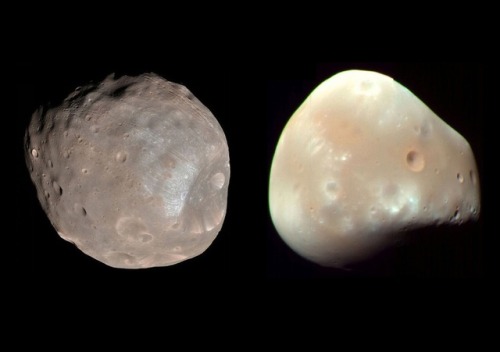
Mars has two moons, Phobos and Deimos, which are small and irregularly shaped. These may be captured asteroids, similar to 5261 Eureka, a Mars trojan.
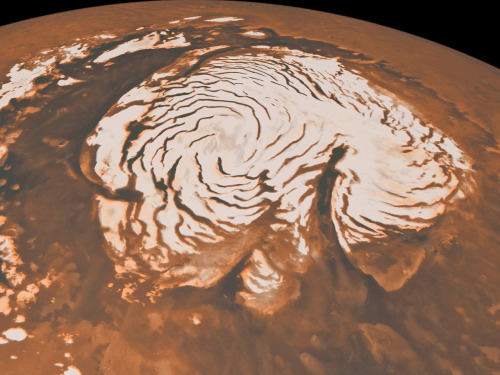
There are ongoing investigations assessing the past habitability potential of Mars, as well as the possibility of extant life. Future astrobiology missions are planned, including the Mars 2020 and ExoMars rovers. Liquid water cannot exist on the surface of Mars due to low atmospheric pressure, which is less than 1% of the Earth’s, except at the lowest elevations for short periods. The two polar ice caps appear to be made largely of water. The volume of water ice in the south polar ice cap, if melted, would be sufficient to cover the entire planetary surface to a depth of 11 meters (36 ft). In November 2016, NASA reported finding a large amount of underground ice in the Utopia Planitia region of Mars. The volume of water detected has been estimated to be equivalent to the volume of water in Lake Superior.
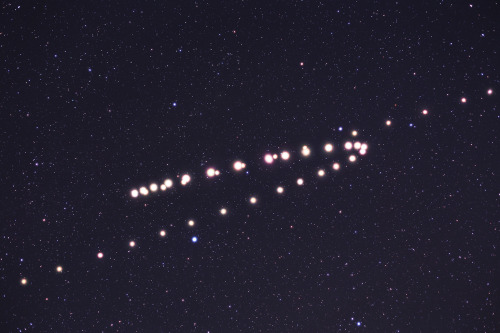
Mars can easily be seen from Earth with the naked eye, as can its reddish coloring. Its apparent magnitude reaches −2.91, which is surpassed only by Jupiter, Venus, the Moon, and the Sun. Optical ground-based telescopes are typically limited to resolving features about 300 kilometers (190 mi) across when Earth and Mars are closest because of Earth’s atmosphere.

Like Earth, Mars has differentiated into a dense metallic core overlaid by less dense materials. Current models of its interior imply a core with a radius of about 1,794 ± 65 kilometers (1,115 ± 40 mi), consisting primarily of iron and nickel with about 16–17% sulfur. This iron(II) sulfide core is thought to be twice as rich in lighter elements as Earth’s. The core is surrounded by a silicate mantle that formed many of the tectonic and volcanic features on the planet, but it appears to be dormant. Besides silicon and oxygen, the most abundant elements in the Martian crust are iron, magnesium, aluminum, calcium, and potassium. The average thickness of the planet’s crust is about 50 km (31 mi), with a maximum thickness of 125 km (78 mi). Earth’s crust averages 40 km (25 mi).

Mars lost its magnetosphere 4 billion years ago, possibly because of numerous asteroid strikes, so the solar wind interacts directly with the Martian ionosphere, lowering the atmospheric density by stripping away atoms from the outer layer. Both Mars Global Surveyor and Mars Expresshave detected ionised atmospheric particles trailing off into space behind Mars, and this atmospheric loss is being studied by the MAVEN orbiter. Compared to Earth, the atmosphere of Mars is quite rarefied.

Mars’s average distance from the Sun is roughly 230 million kilometres (143,000,000 mi), and its orbital period is 687 (Earth) days. The solar day (or sol) on Mars is only slightly longer than an Earth day: 24 hours, 39 minutes, and 35.244 seconds. A Martian year is equal to 1.8809 Earth years, or 1 year, 320 days, and 18.2 hours

Mars is scarred by a number of impact craters: a total of 43,000 craters with a diameter of 5 km (3.1 mi) or greater have been found. The largest confirmed of these is the Hellas impact basin, a light albedo feature clearly visible from Earth. Due to the smaller mass of Mars, the probability of an object colliding with the planet is about half that of Earth. Mars is located closer to the asteroid belt, so it has an increased chance of being struck by materials from that source. Mars is more likely to be struck by short-period comets, i.e., those that lie within the orbit of Jupiter. In spite of this, there are far fewer craters on Mars compared with the Moon, because the atmosphere of Mars provides protection against small meteors and surface modifying processes have erased some craters.
Martian craters can have a morphology that suggests the ground became wet after the meteor impacted.
Source 1
Source 2
images: NASA/JPL-Caltech/Univ. of Arizona , ESA, Tunç Tezel
astronomy facts
“Nothing is more fairly distributed than common sense: no one thinks he needs more of it than he already has.”
— Rene Descartes, Discourse on the Method
I want to live with SOFIA in the sky
What's Inside SOFIA? High Flying Instruments

Our flying observatory, called SOFIA, carries a 100-inch telescope inside a Boeing 747SP aircraft. Having an airborne observatory provides many benefits.

It flies at 38,000-45,000 feet – above 99% of the water vapor in Earth’s atmosphere that blocks infrared light from reaching the ground!

It is also mobile! We can fly to the best vantage point for viewing the cosmos. We go to Christchurch, New Zealand, nearly every year to study objects best observed from the Southern Hemisphere. And last year we went to Daytona Beach, FL, to study the atmosphere of Neptune’s moon Triton while flying over the Atlantic Ocean.

SOFIA’s telescope has a large primary mirror – about the same size as the Hubble Space Telescope’s mirror. Large telescopes let us gather a lot of light to make high-resolution images!

But unlike a space-based observatory, SOFIA returns to our base every morning.

Which means that we can change the instruments we use to analyze the light from the telescope to make many different types of scientific observations. We currently have seven instruments, and new ones are now being developed to incorporate new technologies.
So what is inside SOFIA? The existing instruments include:

Infrared cameras that can peer inside celestial clouds of dust and gas to see stars forming inside. They can also study molecules in a nebula that may offer clues to the building blocks of life…

…A polarimeter, a device that measures the alignment of incoming light waves, that we use to study magnetic fields. The left image reveals that hot dust in the starburst galaxy M82 is magnetically aligned with the gas flowing out of it, shown in blue on the right image from our Chandra X-ray Observatory. This can help us understand how magnetic fields affect how stars form.

…A tracking camera that we used to study New Horizon’s post-Pluto flyby target and found that it may have its own moon…

…A spectrograph that spreads light into its component colors. We’re using one to search for signs of water plumes on Jupiter’s icy moon Europa and to search for signs of water on Venus to learn about how it lost its oceans…

…An instrument that studies high energy terahertz radiation with 14 detectors. It’s so efficient that we made this map of Orion’s Horsehead Nebula in only four hours! The map is made of 100 separate views of the nebula, each mapping carbon atoms at different velocities.

…And we have an instrument under construction that will soon let us study how water vapor, ice and oxygen combine at different times during planet formation, to better understand how these elements combine with dust to form a mass that can become a planet.

Our airborne telescope has already revealed so much about the universe around us! Now we’re looking for the next idea to help us use SOFIA in even more new ways.
Discover more about our SOFIA flying observatory HERE.
Make sure to follow us on Tumblr for your regular dose of space: http://nasa.tumblr.com.
This is why you should always speak your mind

I knew my remark would be unpopular and met with nasty comments, misguided statements about Game of Thrones and the film industry, insinuations that there aren’t any good women or nonwhite directions, couple of lewd comments about my sex life. There is truth to the adage: Facebook is a cesspool.
What I didn’t know is that I would get enough attention to make the top comment.
At the time of writing, sixty hours after initial posting, it’s running a little less than 80% laugh reactions—so, people thinking I’m a moron—and it’s running about 1,100 reactions and 324 replies.
Unfortunately for my would-be adversaries, I don’t debate on Facebook and it is a favorite pastime to read the vitriol and mediocre hash slung in my direction as if it’ll have any effect on my self-esteem. Fortunately, you don’t have to do the same. I present: the major response patterns and why they don’t hold any water.
I love this

Rachel C Lewis | @wnq-quoteoftheday | @wordsnquotes-online
Right?


;-)

Super Blue Blood Moon 2018
Image credit: Chris Voigt




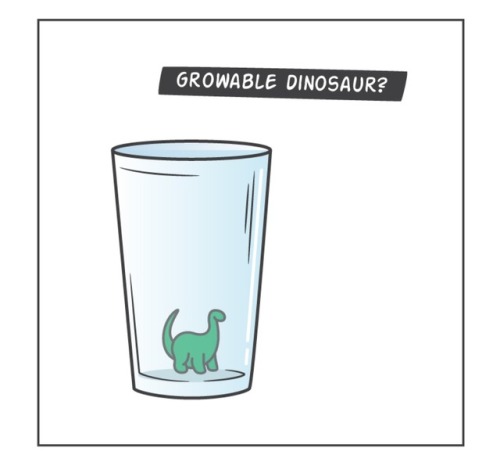



Just Add Water
I’m so mad that a t4 bacteriophage actually looks like that and that it’s appearance isn’t made up
the x files’ nonexistent writers room: one of the biggest holes we’ve dug ourselves into with the william storyline is the existence of his adoptive parents, the van de kamps. mulder and scully can’t just whisk their son away from the only family he’s ever known, right? that wouldn’t be moral or ethical, how do we fix this
james wong:


“TRUST NO ONE”
You can buy it HERE.
😍😍😍

25 years of night shoots, 25 years of frozen lips, 25 years of friendship.
Happy wrap @davidduchovny.
Thanks for taking this ride with me and I’ll see you in January! #TheXFiles




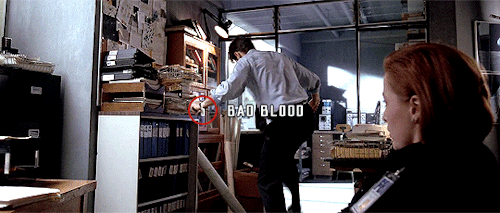

The X Files binge-watch party episodes.
Ain't we?



6/10 favorite quotes - Big damn heroes, sir.





(via BoringEnormous)






Hey look, it’s these guys again. My website – My Facebook page – See me on LINE Webtoon!
I believe


The X-Files Season 11 - 90s print ads inspired
pls credit if you repost.
Some basic science 🤓
Astronomy and Astrophysics: Facts
Here is a list of some curiosities of astronomy and astrophysics. From our solar system to interstellar space.

Mercury is shrinking: It’s small, it’s hot and it’s shrinking. A NASA-funded research suggests that Mercury is still contracting today, joining Earth as a tectonically active planet.

Stellar neighbor: Proxima Centauri is a red dwarf, a small low-mass star, about 4.25 light-years (1.30 pc) from the Sun in the constellation of Centaurus. Proxima Centauri is the nearest star of the Sun that is known and at first can only be seen from the Southern Hemisphere.

A heavy star: 5 milliliters, or one teaspoon of neutron star material, equals the weight of about 900 Great Pyramids of Giza. One sugar cube equates to 100 billion tons. A cubic meter? The entire weight of the Atlantic Ocean. With an escape velocity of 100,000 km/s (Earth’s is a puny 11.3 km/s), a fall from 1 meter above a neutron star would only take one microsecond, and you would impact at around 2000 km/s, or 7.2 million kilometers per hour. This force would destroy all your component atoms, rendering all your matter identical. Fortunately, the closest neutron star is rather far away (about 400 light-years), so I wouldn’t be too concerned about the aforementioned event.

Asteroid belt: The asteroid belt is the circumstellar disc in the Solar System located roughly between the orbits of the planets Mars and Jupiter. It is occupied by numerous irregularly shaped bodies called asteroids or minor planets. About half the mass of the belt is contained in the four largest asteroids: Ceres, Vesta, Pallas, and Hygiea. The total mass of the asteroid belt is approximately 4% that of the Moon, or 22% that of Pluto, and roughly twice that of Pluto’s moon Charon (whose diameter is 1200 km).

Sunlight Takes Around 8 Minutes To Reach Earth: The Earth is located 93 million miles (150 million kms) away from the Sun, a distance known to astronomers as an astronomical units or AU. Traveling at the speed of light (186,282 miles per second), sunlight is able to cross this vast distance in around 8 minutes 20 seconds.

Pluto is about 2,376 km in diameter. Pluto’s small size and low mass mean that it has a density of 1.86 grams per cubic centimeter according to recent measurements by New Horizons, about 40 percent of Earth’s density.

Just like black holes; neutron stars also generate gravitational waves: This year astronomers were able to detect gravitational waves originating from neutron stars. And in addition, it was possible to observe the location of the collision thanks to the efforts of the astronomers. This is a great advance for astronomy.

Most neutron stars are very fast rotators: Since the conservation of angular momentum following a supernova explosion transfers the progenitor star’s rate of rotation to the remnant that is only about 20 km (12.5 miles) in diameter, the result is that the neutron star rotates very rapidly when it is formed. Most known neutron stars rotate several hundred times per second, but the fastest rotator yet discovered, the neutron star designated PSR J1748-2446ad, is known to rotate 716 times per second, which translates into 43,000 rotations per minute, or 24% of the speed of light at the star’s equatorial surface.

Asteroid also has satellite: This color picture is made from images taken by the imaging system on the Galileo spacecraft about 14 minutes before its closest approach to asteroid 243 Ida on August 28, 1993. Ida’s moon, Dactyl, was discovered by mission member Ann Harch in images returned from Galileo. It was named after the Dactyls, creatures which inhabited Mount Ida in Greek mythology. Ida has an average diameter of 31.4 km (19.5 mi). It is irregularly shaped and elongated, and apparently composed of two large objects connected together. Its surface is one of the most heavily cratered in the Solar System, featuring a wide variety of crater sizes and ages.

Kepler-444 system: The oldest known planetary system has five terrestrial-sized planets, all in orbital resonance. This weird group showed that solar systems have formed and lived in our galaxy for nearly its entire existence. Estimated to be 11.2 billion years old (more than 80% of the age of the universe), approximately 117 light-years (36 pc) away from Earth in the constellation Lyra.
Sources: wikipedia, space.com, futurism.com and astronomytrek.com
Image credit: NASA/JPL, ESO/M. Kornmesser, NASA/XMM Newton, Casey Reed/Penn State University, NASA/ESA/Hubble
To learn more about the shrinkage of Mercury, click here.
To learn more about the gravitational waves generated by neutron stars click here.
Who on Earth could ever turn this owl away?

Technovember Day 29. Some owls are born, others are forged by Hephaestus.
Edify yourself 👽










Weird Animal Facts (see 15 more)
He came from a distant star. So far that when he passed by Vega--some 300,000 years ago--Vega wasn't even there yet.

MEET OUMUAMUA, THE FIRST INTERSTELLAR ASTEROID
The whole story is fascinating but these bits caught our attention:
Pronounced “Oh-moo-ah-moo-ah,” it means “a messenger from afar arriving first.”
Observations of the wildly-varying light from ‘Oumuamua showed scientists it wasn’t spherical, but probably had a cigar shape measuring 800 meters by 80 meters by 80 meters—that’s something almost as tall as the Statue of Liberty, but half a mile long. It’s red, and likely made from metal and carbon-rich matter like some comets.
There are many unknown things in our galaxy, and some of them are zooming at us at incredible speeds.
I hope they taste better than Matt Damon's potatoes

Tending Your Garden … In Space via NASA http://ift.tt/2zpxa6R
Great posters, on par titles, sub par episodes.




Star Trek: Discovery midseason finale tonight! Check out the first 8 of my retro episode posters as you prep for Episode 9: “Into the Forest I Go”.










Delicate Temporary Tattoos That Look Like Real Watercolor Illustrations
London-based brand and temporary tattoo designers PAPERSELF prides itself in the creation of artistic temporary tattoos. Adorned with soft pastels and inspired by nature, the watercolor-like temporary tattoos are unique. They follow the new trend of artistic temporary tattoos, which mimic the delicacy of watercolor paintings. Find their entire collection in their Etsy shop.
View similar posts here!
Gifts for every budget
Personalized and custom jewelry
Jewelry shop
Gifts for her
Home gallery
Topic: Etsy, Illustration, Temporary Tattoos, Tattoos || by STAFF